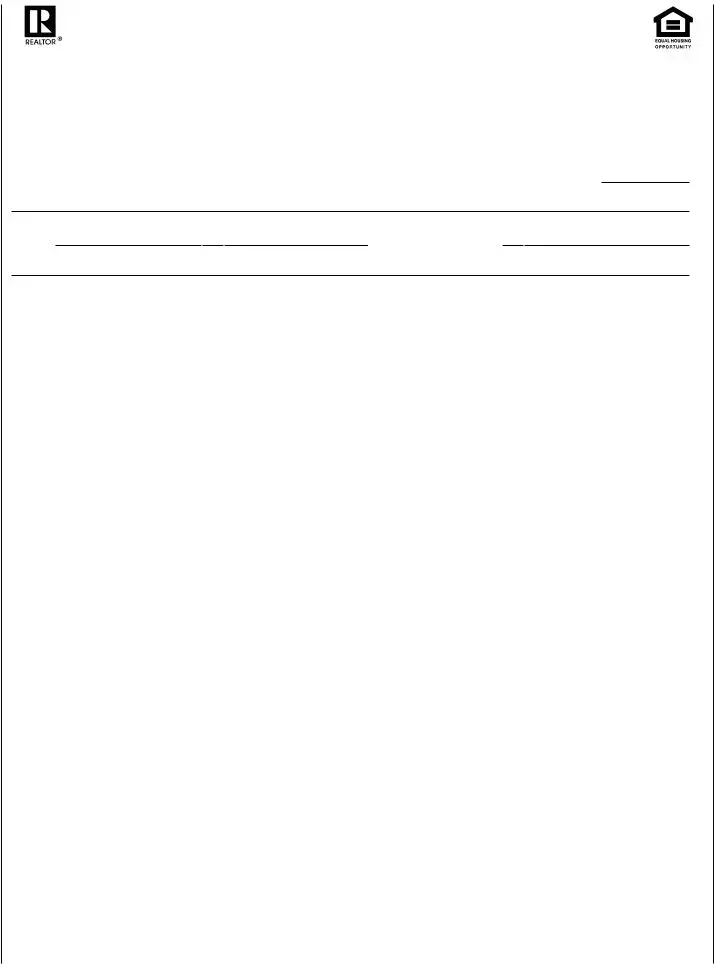351ACKNOWLEDGMENT OF SELLER
352The undersigned Seller affirms that the information set forth in this Disclosure Statement is accurate and complete to the best of Seller’s
353knowledge, but is not a warranty as to the condition of the Property. Seller hereby authorizes the real estate brokerage firm representing
354or assisting the seller to provide this Disclosure Statement to all prospective buyers of the Property, and to other real estate agents. Seller
355alone is the source of all information contained in this statement. If the Seller relied upon any credible representations of another, the
356Seller should state the name(s) of the person(s) who made the representation(s) and describe the information that was relied upon.
357 |
|
|
|
|
358 |
|
|
|
|
359 |
|
|
|
|
360 |
|
|
|
|
361 |
|
|
|
|
362 |
esig_sig_slr1 |
|
esig_datesign_slr1 |
|
363 |
|
|
|
|
|
|
364 |
SELLER |
|
DATE |
|
365 |
|
|
|
|
366 |
esig_sig_slr2 |
|
|
|
367 |
|
esig_datesign_slr2 |
|
|
|
|
|
368 |
SELLER |
|
DATE |
|
369 |
esig_sig_slr3 |
|
|
|
370 |
|
esig_datesign_slr3 |
|
|
|
|
|
371 |
|
|
|
|
372EXECUTOR, ADMINISTRATOR,TRUSTEE
373 |
(If applicable) The undersigned has never occupied the pro perty and lacks the personal knowledge necessary to complete this Disclosure |
374Statement.
375 |
|
|
|
376 |
|
|
|
377 |
|
|
|
378 |
|
|
DATE |
379 |
|
|
|
380 |
|
|
|
381 |
|
|
|
382 |
|
|
DATE |
383 |
|
|
|
384 |
|
|
|
385 |
|
|
|
386 |
|
|
|
387RECEIPT AND ACKNOWLEDGMENT BY PROSPECTIVE BUYER
388The undersigned Prospective Buyer acknowledges receipt of this Disclosure Statement prior to signing a Contract of Sale pertaining to
389this Property. Prospective Buyer acknowledges that this Disclosure Statement is not a warranty by Seller and that it is Prospective Buyer’s
390responsibility to satisfy himself or herself as to the condition of the Property. Prospective Buyer acknowledges that the Property may be
391inspected by qualified professionals, at Prospective Buyer’s expense, to determine the actual condition of the Property. Prospective Buyer
392further acknowledges that this form is intended to provide information relating to the condition of the land, structures, major systems and
393amenities, if any, included in the sale. This form does not address local conditions which may affect a purchaser’s use and enjoyment of
394the property such as noise, odors, traffic volume, etc. Prospective Buyer acknowledges that they may independently investigate such local
395conditions before entering into a bindin g contract to purchase the property. Prospective Buyer acknowledges that he or she understands
396that the visual inspection performed by the Seller’s real estate broker/broker-salesperson/salesperson does not constitute a professional
397home inspection as performed by a licensed home inspector.
398 |
|
|
|
|
399 |
|
|
|
|
400 |
|
esig_sig_byr1 |
|
|
401 |
|
|
esig_datesign_byr1 |
|
|
|
|
402 |
|
PROSPECTIVE BUYER |
|
DATE |
403 |
|
|
|
|
404 |
|
esig_sig_byr2 |
|
|
405 |
|
|
esig_datesign_byr2 |
|
|
|
|
406 |
|
PROSPECTIVE BUYER |
|
DATE |
407 |
|
esig_sig_byr3 |
|
|
408 |
|
|
esig_datesign_byr3 |
409 |
|
|
|
|
410 |
|
|
|
|
|
NJAR® Form-140-7/12 Page 7 of 8 |
|
|







